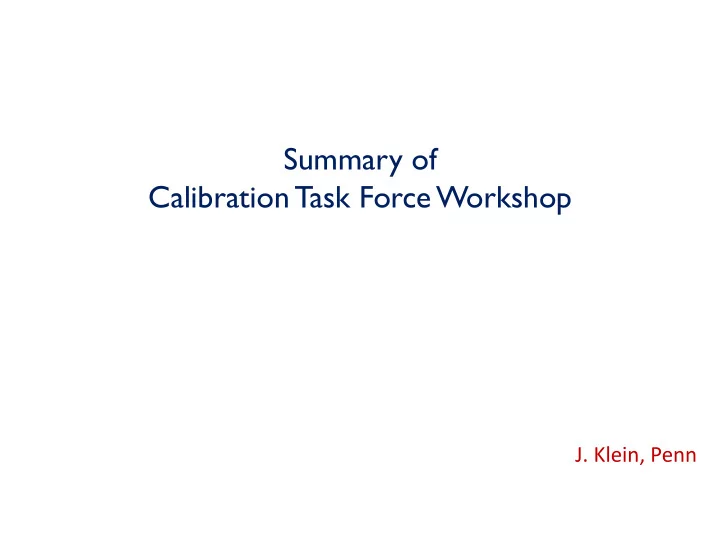

Summary of Calibration Task Force Workshop J. Klein, Penn
Spoiler: Not a lot was discussed regarding CE calibrations--- thought of as responsibility of CE consortium. But calibration requirements impact CE. DUNE Calibrations are not part of any consortium.
DUNE FD Exceptionalism FD differs from other long-baseline oscillation experiments: • Cosmic rate through 10 kt is tiny compared to NOvA • FD is not segmented like NOvA or MINOS • FD ex situ calibrations not possible • FD response changes differently from NOvA or MINOS • FD is not truly monolithic like Super-K • DUNE will not have serious test-beam results • DUNE unlikely to have a functionally equivalent ND • DUNE total neutrino statistics are < 1000 events/year Reconstruction and cut efficiencies on events of interest will be done exclusively with Monte Carlo or extrapolations from tagged events using Monte Carlo. 3
Calibration Status ADC DNI ADC INI CE Transfer Fcn S. Gollapini
Calibration Status S. Gollapini Best calibration is stopping muons (30/day/10 kt)… …one for each APA every 5 days. Physics requirement is <2% uncertainty on dE/dx, 1% energy bias • CE calibration needs to be a small fraction of this budget. •
Calibration Status Electronics Pulsers S. Gollapini
Cosmic Rays APA/CPA for Alignment If alignment doesn’t change and reconstruction is perfect and we T. Junk know v d …might be enough statistics to do this. Reducing dynamic range would decrease cosmic-ray useful statistics.
Laser System Would Do a Lot DUNE’s segmentation is provided by the electric field Need crossing tracks to unambiguously map it-–only laser has statistics K. Mahn I. Kreslo
Laser System Would Do a Lot Known Sources of Electric Field Distortions K. Mahn
Laser System Would Do a Lot Using Laser for Alignment K. Mahn
Laser System Would Do a Lot Laser system data rates [From Georgia] Depends on how finely-grained calibration must be For 10 cm 2 *1 m voxels (about size of space charge distortions) would need 100,000 firings/laser, if we assume each laser traverses entire detector. Anticipate 5 lasers/TPC but if run in parallel then 500,000 triggers needed. Each one (in this paradigm) illuminates nearly every collection wire…At 1 Hz (=6 days of laser running!) this is =6 GB/s = 3 PB/ laser run. Would need to treat laser triggers like 39 Ar---ZS in builder based on trigger bit? Induction ZS could be based on time alone if track direction and position known.
Intrinsic 39 Ar Decay rate in 10 kt is 10 MBq, but endpoint is < ½ MIP M. Mooney • Clearly the success of this depends on precision response at very low energies And having low enough noise levels • • And a dynamic range that extends low enough
Other Low Energy Sources Goal is “understanding” SN response J. Reichenbacher, J. Stock
Other Low Energy Sources “Injected” sources: (”Thoron” or krypton) could be used but very low energy--- Have to run as random triggered like 39 Ar. Neutron source: D-D generator produces ~50k neutrons/pulse, which travel very far in LAr (energy near “anti-resonance”). Produces 6.1 MeV(?) g cascade on capture on 40 Ar. (Svoboda) Neutron source is “easy”---many captures in one readout window. t 0 comes from generator, capture time is ~100 µ s.
Cosmic Ray Tagger/Tracker
Cosmic Ray Tagger/Tracker This is the only way in DUNE FD to directly test track reconstruction with beam- like events without using any constraints from FD itself. Would need some trigger information for DAQ
DAQ M. Graham
DAQ
Summary • Calibration TF work still in early days • Impact on CE will be: Noise levels • Understanding of noise • Dynamic range (from < 39 Ar to downward cosmics)---12 bits maybe not enough • Calibration of gain and overall transfer function, per channel • • Calibration of DNI and INI of ADC, per channel
Brief History of Calibrations in LAr • Measured with cosmic ICARUS Lifetime/Purity ray muons at Gran Sasso • Cosmic ray rate at 4850L • 2x10 -5 Hz/m 2 à 3k/day • Sufficient to measure < t > on several hour time scale • An accurate measure of t can be made using one µ at >15 o LBNE CD-1 Director's Review – 26-30 March 21 2012
Brief History of Calibrations in LAr
Brief History of Calibrations in LAr • Calibration WG formed when DUNE formed • Turned into ProtoDUNE Calibration WG • Merged with ProtoDUNE DRA (“Data, Reconstruction, Analysis”) • Which is now just “Reconstruction” • DUNE FD Calibration Task Force formed (K. Mahn, S. Gollapini); under APA consortium • Now Calibrations are under no consortium
Recommend
More recommend